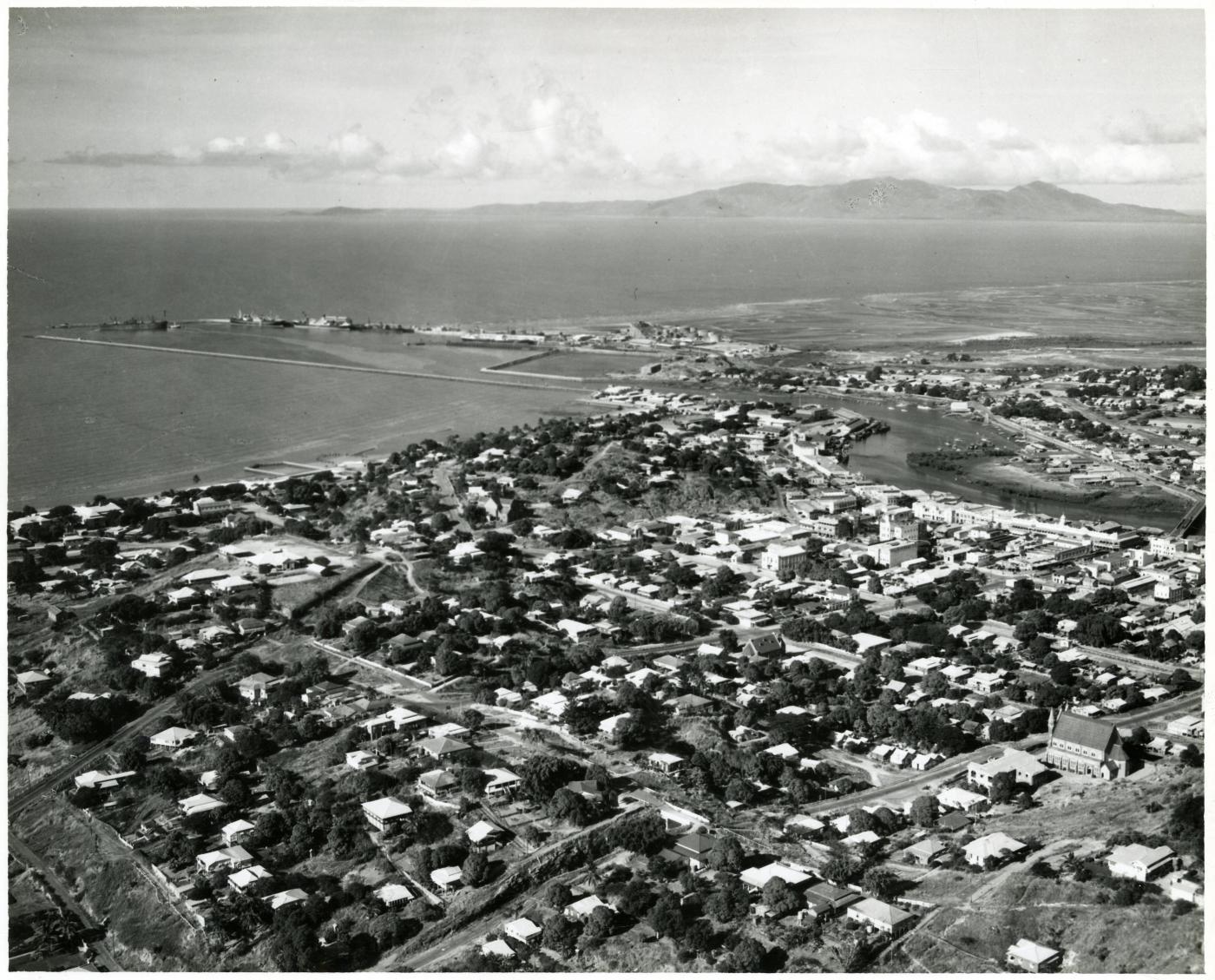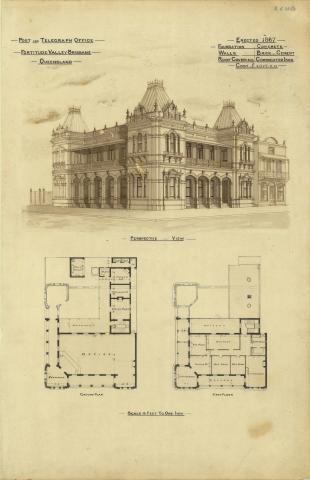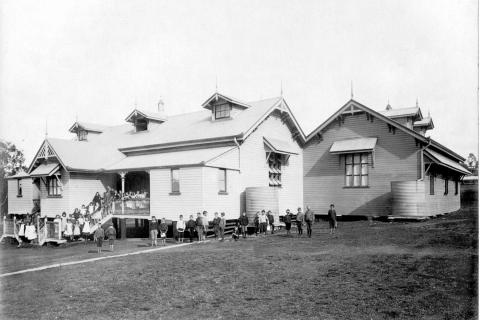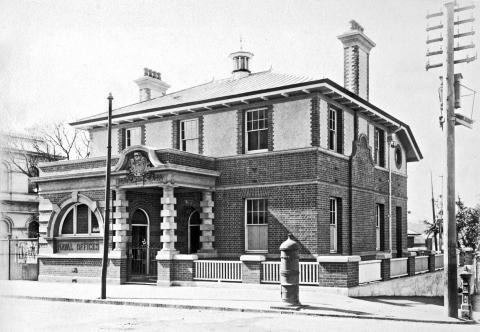
- News of the day
-
Brisbane Courier, Thursday 21 September 1865, page 2
CLEVELAND BAY AND THE TOWNSHIP OF TOWNSVILLE.
By a Traveller
Cleveland Bay, or rather Townsville, which is marked out on its southern shore, is situated in latitude 19 deg. 16 min. south, longitude 147 deg. east, and is distant from Port Denison sixty hours' sail. The first principal headland after leaving Port Denison is Cape Upstart, a high barren mountain. Cape Bowling-green is low and sandy; and next in order is Cape Cleveland, a precipitous rock of red granite, which may be likened to a grim monster guarding the entrance of the bay. The width of the bay here, or from the last mentioned cape to the high land of Magnetic Island, is four miles. This island, which seems as if dropped into the Pacific ocean, is ten or twelve miles long, stretching east and west, and is high, rocky, and barren. Mount Manypeaks, in the centre of the island, is over 200 feet altitude, and devoid of vegetation, except some stunted trees and patches of lichens. The peculiar form or shape of the mainland - the shore curving inward or towards the land, with Magnetic Island as a natural breakwater, forms the fine sheet of water called Cleveland Bay. The length of the bay from Cape Cleveland, coming in from the south to Cape Marlowe when proceeding northwards, is fifteen miles, and its average breadth more than four. Considering the armlets and numerous indentations of the coast, the area may be set down at 80 square miles. The appearance of the land from the sea is not inviting - mountains in the back ground; and as the vessel approaches the shore rocks of every conceivable form and shape come in view. A most remarkable object, and what strongly resembles an ancient castle or keep, is a rock or mountain some hundreds of feet high, and rising like a wall next the bay. This mountain, called by the natives Cooderinga, recently named the Castle-hill, is better than a mile inland, and at some period in the world's history was washed by the waters of the bay; but where the waves rolled, and the sea murmured, and fishes sported, is now rich alluvial land. The singular form of the coast was favorable to this making of land, for, at intervals, the sandy beach is broken by protruding headlands or high bluffs of granite, against which the tide rises at high water. The drift and sand from the sea, and the debris brought down by the rains from the mountains, in course of time filled up the Shell-end inlet, and what was formerly an iron-bound coast, like Wales or Ireland, is now a sandy beach; and hundreds of acres of land, rich beyond description, covered with kangaroo and meadow grass, and dotted with tea trees and silver iron-bark, skirt the margin of the beautiful and tranquil bay. This description, though minute and lengthy, is necessary, for here a large portion of the new township has been marked out or surveyed - a portion only for the township is in three separate places.
West of Cape Cleveland, distant 7 miles, a river (Ross river, named after Mr. Ross), some 200 yards wide, empties itself into the bay. The embouchure of this river is sheltered on the east by the high land of Darling Point; on the west the shore is narrow, almost pointed, and may be said to form the apex of a triangle, whose northern side is bounded by Cleveland Bay ; on the south by the placid waters of Ross River. The base, or third side, abuts on a steep rock, whose summit is crowned by Mr. Black's mansion. This rock covers an area of 70 acres, and ex- tends from river to sea, leaving barely a roadway next the river. At low water, drays can pass seaward of Black's Point. The cape so imperfectly described above is composed of sand and other alluvial matter; contains 17 acres, or 40 allotments, all of which are sold except 11 reserved by Government. At the point where Black's Rock comes nearly in contact with Ross river, the stream bends suddenly, by forming nearly a right angle, and running parallel with the Castle Hill. On the eastern slope of this mountain, 120 allotments have been surveyed. - This part of the township is delightful, Ross River being in front and the Castle Hill is the rear. About forty allotments have been recently sold. The main road leading to the interior, and to the Messrs. Blacks' station, about six miles distant, passes through this portion of Townsville.
Now for the third division: From Blacks' Point to Kissing Point the shore curves slightly. The ground is level, and has been described already. Here 140 allotments have been surveyed, none of which are as yet sold. Ross River, which makes Townsville so valuable as a place of commerce, is deep, runs slowly, admits vessels of considerable tonnage a good way up, and yet is only a part of the main stream. Some miles inland the parent river divides, forming a delta of about 2000 acres. The other branch has sandy flats at its junction with the sea, and is quite unfit for shipping purposes.
Townsville (named in honor of Capt. Towns, of Sydney, the principal man of the firm of Ross, Black, and Co.) so quiet a year ago, is destined ere long to become a great town or commercial city; and on the shores of Cleveland Bay, and borders of Ross River will be heard the hum of busy industry, and all the noise and bustle of a thriving seaport town. Broad streets are laid out, extensive wharfs planned, and stately buildings will soon cover the ground once shaded by the gum tree and iron bark, It is scarcely twelve months since the first drays from the interior made their way to the shores of Cleveland Bay, and yet during that time a great change has been effected. Certainly the company (Ross Black, and Co.) deserve great praise for their energy and activity. The mangroves have all but disappeared from the river's edge. The timber on Sandy Cape has been cut down. A lagoon fenced, a wharf and warehouse have been built, also a smith's forge, butcher's shop, a cottage ornee, a large hotel, and many other buildings are in course of erection. Mr. Black's mansion, when finished, will be a prominent object, as seen from the bay ; Messrs. Seaward and Marsh are erecting stores, and no doubt other commercial firms and private individuals will soon follow. Timber, for ordinary purposes, such as fencing, house blocks, stretchers, and uprights, is quite abundant. Water can be had anywhere, by sinking round the base of the Cattle Hill; and a good well, over which is a pump, gives water to the carpenters and others residing at Townsville. This pump is about a stone's throw from the beach. The climate of Townsville and adjacent country is healthy; the summer is warm, but the sea and land breeze blowing alternately cools the air, and the heat is not much felt. There are no marshes or swamps in the immediate neighborhood of the township. This, and the contiguity of the place to the sea, will ensure that the diseases so common in many parts of the colony will he unknown here. There is also very little, if any, scrub land near the bay.
Viewing the position of the place, a more eligible site for a township could not be selected. The bay is sheltered; and in the mariner's track, going to and coming from the north, soundings taken along the ship's course gave a depth of not less than 15 feet of water. Vessels of moderate tonnage can ascend Ross River without breaking hulk in the bay, and unload and take in their cargo at the wharf. When the interior of the country is opened up and suitable and good roads made, Townsville will be the emporium of the produce of hundreds of acres of back country, and be a place of first-rate importance.
- Background
-
TBA
/146.8042685,-19.2575199,7/450x450@2x.png?access_token=pk.eyJ1IjoicXNhLWRpc2NvLXFsZCIsImEiOiJjamJmdTgyZXEyeWNjMnlxZm8xcmtieHgxIn0.lmT9J5tTPKGuuccQgCVSAg)



